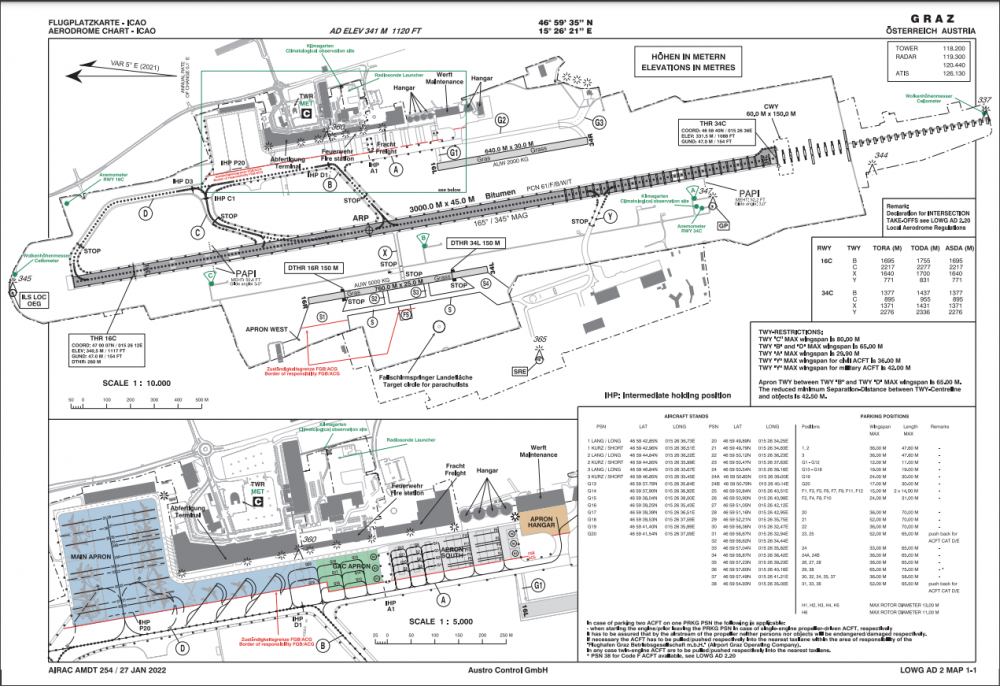Pilot Resources
Overview. Graz Airport (IATA: GRZ, ICAO: LOWG) is a primary international airport serving southern Austria. It is located near Graz, the second-largest city in Austria, in the municipalities of Feldkirchen and Kalsdorf, 5 NM (9.3 km; 5.8 mi) south of Graz city centre.
Runway Use. In calm conditions, runway 16C is used for departures and 34C for arrivals. At wind speeds exceeding 10 kts the runway with the greatest HWC should be used.
Transponder Use on Ground. Mode S transponder is mandatory. Select AUTO mode and assigned Mode A code. If AUTO mode is not AVBL, select ON or GND and assigned Mode A code.
- from the request for push-back, start-up or taxi whichever is earlier;
- after landing, continuously until the ACFT is fully parked on stand;
- when fully parked on stand select STBY.
Scenery. There are multiple add-on sceneries available for Graz Airport. If you are using FSX/P3D, we strongly recommend that you download one because they incorporate recent updates that are not included in default scenery. If you decide to fly with scenery that is not included in the approved list, then make every effort to follow the controllers' instructions referencing the published taxiway diagrams.
| MSFS Approved | FSX/P3D Approved | XP11 Approved |
|---|---|---|
| ➢ ORBX Graz | ➢ FSDG Graz | ➢ FSDG Graz |
| ➢ X-Plane.at Graz |
Charts. Charts can be obtained from several providers, however, it is highly recommended you visit the Austrocontrol Aeronautical Information Publication (AIP) which is accessible HERE. From there, select the latest airac cycle -> Part III - AD -> AD 2 -> select Karten/Charts below LOWG. Since the respective link changes with each new cycle a direct link won't be supplied.
Uncontrolled Operations. The following frequencies should be utilised only when POSCON ATC is offline.
| Station | VHF Frequency |
| Graz ATIS | 126.130 |
| CTAF | 118.200 |
Terminal Layout.
Gate Assignment. Graz doesn't have specific stands for airlines.
Start-up Clearances. Start-up clearance will be provided once the aircraft is ready to move from it's stand. Aircraft will request pushback once ready to do so from the tower controller. Planes at the stand 1-3, GAC Apron and Apron South don't require pushback as those are taxi-out positions.
General Aviation. General Aviation planes as well as small business jet's receive stand at the GAC Apron and Apron South. SEP and MEP GA planes that operate under IFR conditions require a start-up clearance prior to starting the engine. If operating under VFR no start-up clearance is required.
CPDLC Login. LOGON: LOVV
Taxi Procedures. Taxiway B closed for code letter F aircraft, MD11 and B764. Oversteering required at taxiway D for following aircraft: A346, A35K, A388, B744, B748, B764, B773, B789, B781, MD11. Following restrictions apply for code letter F aircraft:
- Landing RWY 16C: Backtrack on end of RWY - TWY C - stand 38
- Landing RWY 34C: Exit via TWY C or D - stand 38
- Departure RWY 16C: Stand 38 - TWY D - RWY 16C
- Departure RWY 34C: Stand 38 - TWY C - backtrack on turn pad THR RWY 34C
ATC Procedures.
| AG1 | Graz Radar (Main position) | 119.300 |
| AG2 | Graz Radar | 120.440 |
| TG | Graz Tower | 118.200 |
De-Icing Procedures. De-Icing is available at the stand.
Noise Abatement Procedures. Please refer to the AIP of Austria HERE. Aktuelle Ausgabe / current version -> PART III - AD -> LOWG
Speed Restrictions. Unless otherwise instructed or approved by ATC, maximum airspeed below 10.000ft in class D, E and G airspace is 250 KTS IAS.
Clear The Runway. The runway should be vacated in the most expeditious manner. If unable to comply, advise ATC.
ATC Procedures. Due to high terrains to the north and west of the airport, familiarization with the MRVA/MVA is advised. Alternatively aircraft should be cleared via the respective STAR and possibly transition along with the vertical profile for each respective IAP.

